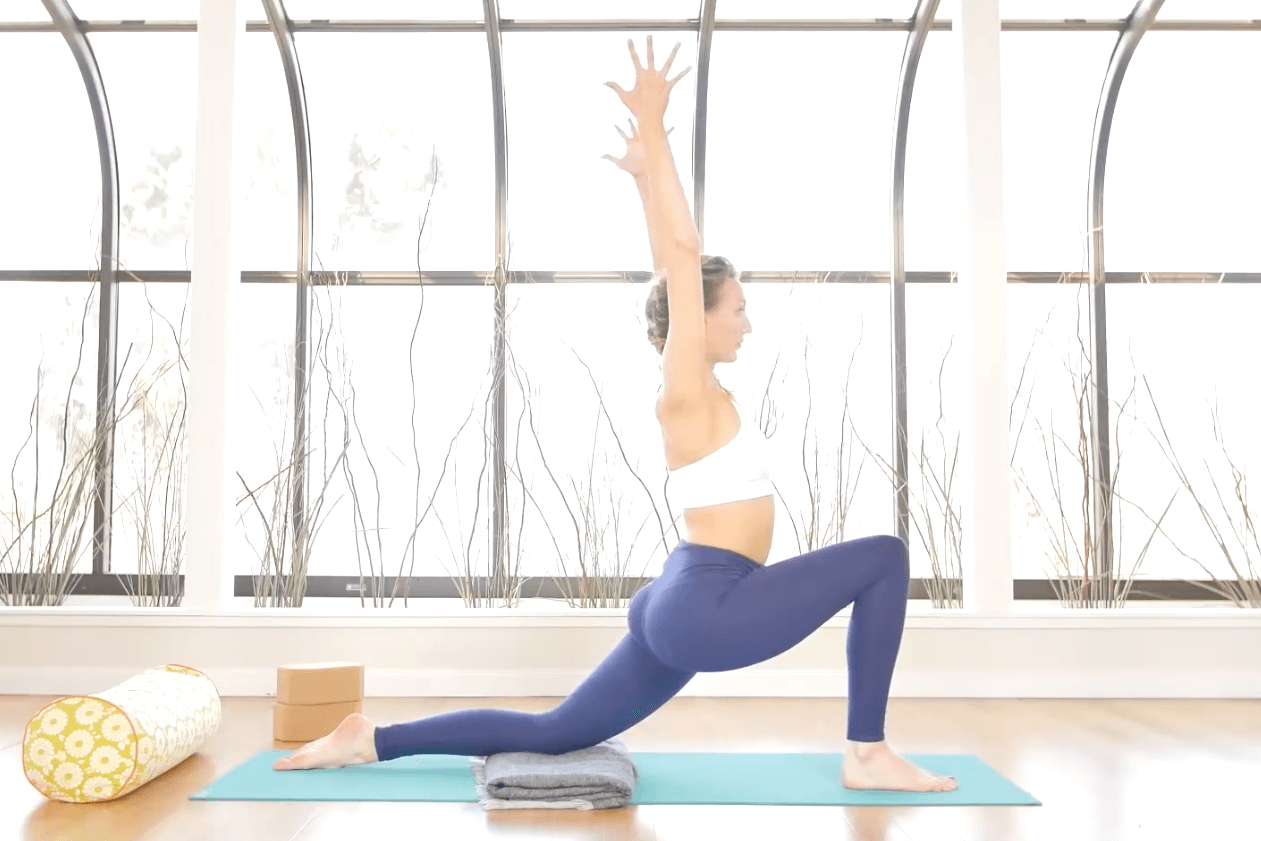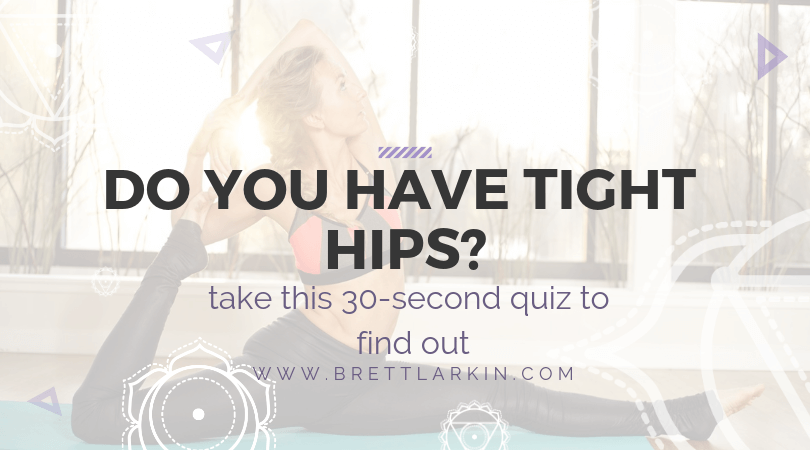“How do I even know if my hips are tight?”
This was one of the replies I got last week, when I sent an email about my new, 4-week, Hip Opening Program.
My answer:
“Tight” is a relative concept, which will vary person-to-person. We all have different fitness goals so what one person think is tight, may be satisfactory for someone else.
Just because one person can put their left foot over the left shoulder without crumbling into muscle spasms doesn’t mean that you need to be able to do the same…
…or that you should want to!
What I can say is that most people can feel their tight hips when they reach across their body for something, try to bend forward over their knees while sitting and are met with a quiet scream from their muscles, or feel a bit of discomfort when they try to sit on their knees.
Sound familiar?
Yup. It’s likely that you also have tight hips.

The first thing to understand is that there are a lot of things that we do on a daily basis that can lead to tight hips. The next thing to understand is that there is no quick fix when it comes to tight muscles of any kind.
Nope, sorry. One quick round of yoga for tight hips isn’t going to miraculously strengthen weak hip flexors and increase mobility in 30 minutes.
But that doesn’t mean that it won’t help you improve mobility in the group of muscles we know as the hips.
In fact, with a dedicated practice on a daily basis, a little bit of work, and deep breathing, you can increase your mobility and reduce pain that comes from those dreaded tight hips.
Plus, there are tons of other benefits that maybe you haven’t even thought of yet.
Maybe you’ve got back pain and you’re looking for a little relief.
Or maybe you’re running or biking a lot and looking to cross-train?
Or you’re finally trying to sink into Splits and King Pigeon? (the Lord knows that stepping into those poses takes a lot of work and deep breathing.)
Trying to sink into Splits and King Pigeon?
Whether you just want to add more stretching into your routine or want to pretzel yourself into Full Lotus, here is a quiz you can do in less than 30-seconds to see where your hips are at:
If you’ve got tight hips and you wanna start working them right away, then get started with this video (it’s perfect for beginners or for lounging around the house):
Okay, so now that you have an idea of whether or not your hips are tights, it’s time to break it down a little bit.
But I don’t want you to go into this thinking that with a few rounds of a tight hips yoga flow you should be able to relax into frog pose like your yoga instructor (wouldn’t that be the dream?!).
In fact, advanced poses like that can take years of work to get to. Years of simple exercises, lots of patience, and a whole lot of stretching of the quadriceps, hamstrings, spine and pelvis.
So relax where you are and get comfortable with the process. This is yoga after all 🙂
1. The state of your hips is never static
While the quiz above can help give you a baseline, the body is changing, day-to-day.
For example, when I got off my 14+ hours of plane travel to Europe, my usually open hips were crazy tight.
If I run stairs (naturally favoring my right leg), my right hips clench up and sometimes causes hip pain.
One of my favorite parts of a hip opening practice is observing how much the hips change pending what’s going on in my life (physically and emotionally), as well as how different the hips can be from side-to-side.
Even if you have very open hips, life happens.
In fact, the top causes of tight hips really come down to how you spend your time each day.
Are you sitting long periods of time during the day, limiting your hip mobility for most hours of the day? Do you exercise regularly, often in a repetitive motion, such as running or CrossFit (hello, power clean)? Do you regularly lift heavy objects, putting a major strain on the group of muscles connected to your hips, such as your glutes, hamstrings, and lower back muscles?
Needless to say, our daily habits can have a big impact on our hip flexibility. Tightness can take hold of our hip flexors, psoas, and all of the ligaments and tendons connecting the two areas.
Trying yoga for runners, having a go-to hip opening practice, or doing yoga for hip pain can help you navigate and adjust.
2. You may have no idea that you have tight hips
Until I did Pigeon Pose in my first yoga class over a decade ago, I had no idea I could even stretch that part of my body or that I carried any tension in my hips whatsoever.
I had literally ZERO awareness of this area, even though I could sit cross-legged on the floor, danced, did Pilates, and considered myself fairly flexible.
Once I got a glimpse at the other side (what my body felt like, post-hip opening), I got really addicted and wanted to open them more, more, more.
I remember even saying to a friend “Why did no one tell me I could open my body like this?”
My mind was pretty blown.
Once you switch that part of your mind onto your hips, then you can start to incorporate hip-opening exercises into your daily practice. That’s when the magic begins.
3. Hip-opening stretches make a big impact
The muscles around your hips and hamstrings are some of the largest in the whole body.
Your hips help stabilize your pelvis, which is where your upper body and lower body intersect.
Your pelvis (in my opinion) is basically the most important area to focus on to create radical shifts in your alignment and overall health.
Basically, if you love the 80/20 rules and want to focus on one area that will give the most impact, concentrate on working with your hips.
In terms of stretching for your overall health, it’s the biggest bang for your buck. If you want to increase your overall flexibility, then begin with the hips.
If you haven’t already, get started on my new *Hip Opening Training Guide* and be amazed by the transformation in the flexibility of your hips and overall health. And take a look at my free online yoga videos for some sequencing that will help loosen your hips with a daily practice.
Brett
Experience 3 Training Videos from Inside My 200-Hour Online YTT

YOU MIGHT ALSO LIKE
- What is Kriya Yoga? The Philosophy and Practice
- Uddiyana Bandha: Tapping Into Your Deep Core
- 4 Reasons Hasta Bandha Is Essential To Your Yoga Practice
- Vitarka Mudra: What It Is and How Do You Use It?
- Shakti Mudra: What It Is and How Do You Do It?
- Garuda Mudra: What It Is and How Do You Use It?
- Kali Mudra: What It Is and How Do You Do It?
- Shunya Mudra: What It Is and How Do You Do It?
- Varuna Mudra: What It Is and How Do You Use It?
- Vayu Mudra: What It Is and How Do You Use It?
- Samana Vayu: The Energy of Balance & How to Access It
- Apana Vayu: The Energy of Release & Surrender
- Udana Vayu: The Ascending Wind
- Prana Vayu: The Breath of Vitality
- Vyana Vayu: The Energetic Secret to Flow
Learn how to do 11 of the most popular yoga poses correctly. Free video + PDF download.











